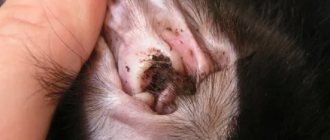Danil Ignatievich Safronov
veterinarian Petstory
Calcivirosis in cats is a very common infectious disease, the causative agent of which is very contagious and can easily mutate. Most often, the virus affects the upper respiratory tract of cats, but pathogenic effects on other organ systems are also found. After contact with the pathogen, the incubation period (from infection to the appearance of the first symptoms) lasts, according to various sources, from 2 to 14 days.
Description of the disease
The disease is caused by the Feline calicivirus (FCV). It affects the upper respiratory tract and oral mucosa. Feline calcivirus is registered all over the world, including in Russia. It affects domestic and wild representatives of the cat family. There is no breed selectivity for this infection. Calcivirus is one of the most common causes of upper respiratory tract diseases in cats (along with the herpes virus). Kittens over 2 months old and young kittens up to 2 years old are susceptible. They make up about 90% of the total number of sick animals.
On a note! If the cat is vaccinated against calcivirus infection, then suckling kittens will be protected from infection during the period of feeding with cat milk.
Calcivirus has many variants (more than 40 strains are known). During reproduction, the pathogen exhibits high variability. In this respect, it is similar to the human influenza virus. Strains of the virus differ in symptoms and severity of the disease. Calcivirosis is considered a mild infection. It is dangerous for small kittens, animals with weakened immune systems, old cats or those with chronic diseases. Cats become infected with calcivirus infection throughout the year. The peak incidence occurs in the autumn-winter period.
Consequences of calcivirosis in cats
After completing a course of medication, the recovered pet acquires specific immunity to the pathogen. Re-infection is extremely rare, but it is premature to talk about stable immunity in those who have recovered from the disease.
Is the cat still a carrier of calcivirus?
Often the cat does not show any visible symptoms after suffering from an illness. The owner should remember that an apparently healthy pet can be very contagious to other relatives.
Research by scientists from the UK has confirmed that during the first month after the cessation of the disease, all former patients remain active carriers of the bacterium. During this time period, it is necessary to avoid visiting places where there are unvaccinated or young individuals under 1 year of age. It is not recommended to invite guests who have mustachioed pets into the house so that they cannot spread the infection on outer clothing, shoes or hands.
Over time, the transmission activity of the pathogenic microorganism decreases greatly. So, after two and a half months, only about 50% of recovered animals remain carriers. Unfortunately, there are individuals with a very weakened immune system who continue to remain a carrier of the infection for life.
It is quite simple to identify a cat carrying the virus: it still has problems with the oral cavity. They are expressed in a very unpleasant odor, periodic stomatitis or gingivitis. Any redness in the mouth and excessive salivation should alert the owner. In a cat that has had calcivirus within the last year, this becomes the reason for a trip to the veterinary clinic.
Owner Irina:
My cat suffered from calcivirus at a young age. Now the person who has recovered from the disease is left with bad breath and the fear of going hungry (he could not eat during his illness). But overall, this is an absolutely healthy cat - so don’t waste your time and energy! Calcivirosis is treatable, and you can do without terrible consequences.
Prognosis for recovery
The prognosis is favorable if we are talking about an adult and timely initiation of treatment. In small kittens and very elderly animals, it is more difficult to make predictions: it all depends on the body’s resistance. The veterinarian will definitely warn you that death is possible, but with proper care and intensive treatment it is reduced to almost zero.
Repeat tests for complications
Many veterinarians tend to believe that calcivirosis and its treatment place a heavy burden on the kidneys and lead to early chronic renal failure (CRF). Research is currently underway in this regard. At risk are animals that have suffered a severe case of calcivirus, as well as kittens that were ill at a young age.
The virus can cause complications in other body systems: the gastrointestinal tract, liver, lungs and trachea. Many disorders occur latently for several years, and then make themselves felt in the final stage, when treatment comes down to maintaining a decent standard of living - and nothing more.
To prevent dangerous consequences, it is important to donate blood after the animal is completely cured after 6-8 months for general and biochemical analysis. If any organ is damaged as a result of a severe course of the calcivirus, tests will show this. The owner will be able to begin timely treatment.
Routes of infection
Sick cats release the virus into the external environment through discharge from the eyes and nose, and saliva. When you sneeze, the infection spreads through the air several meters around. The virus can easily be brought into the house from the street on clothes, shoes, or hands.
Attention! Domestic cats often become infected through contact with an outdoor kitten brought into the house.
The main routes of infection with calcivirus infection:
- contact with a sick animal;
- airborne;
- through household items - tray, bowls, combs, bedding, cat houses, toys.
Transmission of the pathogen through urine and feces is of less importance. Cats primarily become infected through the mouth or by inhaling viral particles. The virus persists in the environment for about 1–2 weeks, less often up to 1 month. This depends on external conditions - the presence of wet cleaning, indoor air parameters. Humidity and low temperatures increase the viability of the virus. The risk of an infectious outbreak exists in nurseries, with group housing of animals, the appearance of new cats, with poor feeding, and poor indoor air (dusty, dry, hot). Group housing increases the virulence of the virus, and the infection can be more severe.
Symptoms of calcivirosis
Adult cats often become subclinically or asymptomatically ill. An acute course of calcivirosis is noted in kittens. The incubation period lasts from 2 to 17 days. Usually the first symptoms appear 3–5 days after infection. Characteristic:
- bouts of sneezing for 1 – 2 days;
- inflammation of the mucous membrane of the eyes;
- lacrimation;
- runny nose.
On days 3–5 of illness the following are noted:
- increase in body temperature by 1 - 1.5 ° C, in kittens up to 40 - 41 ° C;
- loss of appetite;
- weakness;
- Thick mucus or exudate with pus is released from the eyes and nose;
- the nose is stuffy, the cat breathes through its mouth.
Further symptoms characteristic of calcivirus infection develop.
- Stomatitis and gum inflammation. Red spots appear in the oral cavity on the palate, tongue, and later ulcers form there. They can be on the nose and in the nasal cavity. The cat eats and drinks poorly, makes pushing movements with its tongue, as if it was choking, scratches its nose, coughs, and sneezes. The gums are inflamed, red, swollen, and sometimes a whitish coating is visible on them. There is an unpleasant odor coming from the mouth.
- Profuse drooling.
Body temperature returns to normal after 3–4 days. In kittens and older animals, the infection can develop into viral pneumonia and shortness of breath develops. Inflammation spreads to the trachea, bronchi, and larynx.
Sometimes atypical symptoms appear:
- skin ulcers;
- inflammation of the joints (acute arthritis) - lameness, pain that goes away after a few days;
- ulcers in the stomach and intestines (very rare).
The disease lasts on average 7–10 days , but can last up to 14–21 days . The animal recovers, but continues to release the virus into the external environment. It infects other cats and may have periodic outbreaks of infection. Carrier cats infect their offspring.
Important! After a few months, the intensity of virus release into the external environment decreases. After three months, approximately half of the cats are no longer a source of infection. But some animals remain carriers of the virus for life.
In severe cases, the cat dies from the infection. This mainly occurs due to various complications, the most likely of which are pneumonia and bacterial infection. Death occurs a few days after the onset of the disease. Before death, kittens develop diarrhea, vomiting, and severe weakness. Calcivirosis can become chronic. This is facilitated by the lack of proper treatment and low immunity. The chronic form of calcivirosis manifests itself as stomatitis and gum inflammation. With this form of the disease, the cat requires a course of treatment with immunomodulators every three months. In isolated cases, the disease occurs as a severe systemic infection. It is caused by highly pathogenic strains of calcivirus - vsFCV. The pathogen enters the animal’s body in the usual way, but is not limited to the respiratory tract. The virus infects the inner layer of blood vessels, liver cells, and pancreas. Severe damage to internal organs develops:
- hepatitis;
- pancreatitis;
- nose and intestinal bleeding.
With this form of the disease, swelling of the paws and head, the appearance of ulcers on the animal’s skin, and jaundice are possible. With a systemic infection, more than 60% of sick cats die.
Definition of disease
Rhinotracheitis in cats is a common infectious disease caused by the herpes virus. Kittens aged 1.5 to 6 months are most susceptible to the disease. But adults can also easily become ill upon contact with a source of infection.
With timely recognition of the symptoms of rhinotracheitis in cats and proper treatment, recovery occurs in 80-95% of cases. Vaccination is an effective way to prevent the development of pathology.
The disease occurs in acute and chronic forms, in which a long period of remission alternates with bouts of relapse. After recovery, 80% of pets remain carriers of the virus for life.
Important! Often viral rhinotracheitis in cats is complicated by infectious diseases such as chlamydia, mycoplasmosis or calcivirosis. This increases the mortality rate, especially in kittens and pets with weakened immune systems.
Diagnostics
Diagnosis of calcivirosis is not difficult. The development of acute respiratory disease in cats under 2 years of age, accompanied by characteristic clinical signs, suggests a calcivirus or herpesvirus infection. If there are ulcers in the mouth, then it is a calcivirus. To clarify the diagnosis, laboratory tests are performed.
- A swab of nasal and eye discharge is taken. A PCR study is carried out (determining the virus by genome). It is possible to grow the virus in cell culture, but this method is not widely used. PCR is also used to identify carriers of the virus. If the pathogen is detected in the blood a year after the illness, then the infection has become chronic.
- Blood chemistry. A decrease in hemoglobin levels by 25–30% is detected.
- Serological studies using the method of paired sera.
- If pneumonia is suspected, an x-ray of the lungs is taken.
It is necessary to differentiate calcivirosis from panleukopenia, herpes (feline rhinotracheitis), chlamydia and rabies.
- Herpes is characterized by inflammation of the cornea with ulceration and cough. There is no stomatitis, mouth ulcers, drooling, or lameness.
- With chlamydia, a spasm of the eyelid and the release of the third eyelid into gas are noted. There is no drooling or mouth ulcers.
- With rabies, there are signs of brain damage (changes in behavior, seizures, convulsions). No mouth ulcers, runny nose.
- Panleukopenia (cat distemper) occurs with abdominal pain, vomiting, and leukocytes in the blood are greatly reduced.
Establishing diagnosis
To develop the correct treatment regimen for rhinotracheitis in a cat, it is necessary to make an accurate diagnosis and identify concomitant infections. A veterinarian makes a presumptive diagnosis based on anamnestic data and examination of the animal. Laboratory tests may be ordered to clarify.
Diagnostic methods
One of the developed methods for detecting the FHV-1 virus is the isolation in cell culture of the pathogen obtained from smears from the conjunctiva, nasal or oral cavity. However, the unpopularity of this method is due to the length of time it takes and the lack of clear standards.
Serological research methods are not very informative, since antibodies to the causative agent of rhinotracheitis are produced in the body only 20-30 days after the initial infection.
There is also a high probability of obtaining a false result if the animal still has antibodies to the vaccine strain of the virus in its blood. Therefore, experts currently prefer PCR diagnostics.
The principle of the PCR diagnostic method is to isolate the DNA of the herpes virus from swabs and scrapings from the affected organs.
Important! Before taking PCR tests, it is prohibited to use local anesthetics, as they affect the correctness of the indicators. Also, at least 14-20 days must pass between vaccination or a course of treatment for rhinotracheitis and testing to exclude a false positive result.
Due to the need to maintain sterility, sampling of pathological material for PCR is carried out by a specialist in a clinical setting. Within 24 hours, the material is delivered to the laboratory.
Differential diagnoses
Viral rhinotracheitis in cats is often associated with calcivirosis, chlamydia bordetellosis or mycoplasmosis. If these infections are suspected, the doctor may order additional tests with these pathogens.
When developing treatment for rhinotracheitis in cats, it is also necessary to establish the presence of bacterial microflora, including Staphylococcus spp. and Escherichia coli. For the correct selection of antimicrobial agents, tests are carried out to determine the sensitivity of these bacteria to antibiotics.
Treatment
If there are no complications, then the cat can be treated at home. When kept in groups, sick individuals are isolated. Separate inventory is allocated; service personnel change their overalls, wash and disinfect their hands. Disinfect the premises where the sick animal was located. Therapy is carried out in several directions.
On the first day, while the pathogen is circulating in the blood, it is possible to administer the specific serum Vitafel. The drug contains gamma globulins for three cat infections: calcivirus, herpesvirus and panleukopenia. In severe cases of the disease, the administration of Vitafel is repeated every other day. If the serum was not applied on the first day of the disease, then treatment with it at a later date is ineffective.
Attention! All medications are prescribed by a veterinarian after examining the cat. Self-medication can be dangerous.
To reduce the likelihood of an allergy to serum, antihistamines are prescribed:
- Suprastin;
- Diphenhydramine;
- Tavegil.
If a bacterial infection develops, antibiotics are prescribed:
- Amoxiclav;
- Ceftriaxone or other cyclosporine drugs.
Immunomodulators stimulate the production of immune response factors:
- Fosprenil;
- Roncoleukin;
- Ribotan;
- Reaferon;
- Immunofan;
- Katozal;
- Cycloferon;
- Maxidin.
For joint damage and signs of lameness, injections of anti-inflammatory drugs are given:
- Ketofen;
- Rimadyl;
- Stop arthritis.
The oral cavity is irrigated with disinfectant solutions:
- Furacillin;
- Chlorhexidine.
Ulcers in the mouth and nose are lubricated with Lugol's solution with glycerin or Vinilin.
For general strengthening of the body, complex vitamins are prescribed in injections, since the cat eats and drinks poorly. Some preparations contain amino acids in addition to vitamins:
- Gamavit;
- Multivit;
- Ultravit;
- Aminovit.
In case of dehydration and severe intoxication, detoxification solutions are administered intravenously:
- Reopoliglyukin;
- Sorbilact;
- Ringer's solution;
- glucose solution 5%;
- Ringer-Locke solution;
- Hartmann's solution.
Usually, with this condition, the cat is hospitalized in a hospital.
- Remove exudate from the eyes and nose with a damp cotton pad. For severe nasal congestion, it is recommended to instill 0.025% Afrin (children's nasal drops) one drop in one nostril, the next day in the other, for 5 to 7 days.
- Purulent conjunctivitis is treated with eye drops (Maksidin). They are instilled three times a day after cleaning the eyes. Instead of drops, you can use tetracycline eye ointment; it is placed behind the lower eyelid twice a day.
During illness, the cat is switched to wet food - canned food, preserves. The food is slightly heated so that the animal smells better. If the pet refuses water, then they practice forced watering from a syringe. The room must be provided with moist, cool air and regularly ventilated. Treatment of calcivirosis in cats can last up to 2 months, depending on the severity of the disease and complications.
Susceptibility
Content
The disease is known in many countries of the world. Cats of all age groups and breeds are susceptible to calcivirus. Greater susceptibility to infection is observed in kittens up to three months. For them it is acute, quite intense, and quickly leads to death. Mature cats are characterized by the transition of diseases to the chronic stage.
The causes of the risk are considered to be reduced immunity as a result of other, recently suffered diseases, and incorrect vaccination or its inaccessibility.
In closed households, calcivirosis occurs in cats quite rarely. The incidence of disease between animals kept in kennels is much higher. The maximum circulation of the infectious agent is recorded in autumn and winter.
Possible complications
In most cases, calcivirosis is complicated by a bacterial infection. The probability of death increases to 60%. Other complications of feline calcivirus infection:
- pneumonia;
- dehydration;
- tooth loss due to gum inflammation;
- renal failure in chronic course.
Prevention
The only reliable way to prevent calcivirus infection in cats is vaccination. Veterinarians include vaccination against this disease in the standard vaccination regimen. The vaccine does not completely protect a cat from infection with calcivirus, since there are many varieties of it. But the presence of immunity makes it easier to endure the infection and avoid complications. The likelihood of infection is also reduced. Vaccinations begin for kittens from 8 to 12 weeks of age. The vaccine is administered two or three times. Afterwards, revaccinations are done every 1-3 years. Vaccines contain different numbers of strains. There is no biological product that can protect cats from all types of calcivirus. Complex vaccines are used for vaccination.
- Nobivac Ducat. Intervet , Holland. Live dry vaccine against viral rhinotracheitis and feline calicivirus. Initially, they are vaccinated twice with an interval of 3–4 weeks. Immunity is developed 10 days after the second administration, its duration is 12 months. Nobivac Ducat can be used from 6 weeks of age.
- Nobivac Tricat . Vaccine against calicivirus, viral rhinotracheitis and feline panleukopenia live dry. The characteristics of the drug are similar to the previous vaccine, but it can only be used from 8 weeks of age.
- Multifel-4. NPO "Narvak" , Russia. Inactivated (killed) vaccine against panleukopenia, rhinotracheitis, calicivirus and feline chlamydia. Kittens are vaccinated at the age of 8 – 12 weeks. The vaccine is administered twice with an interval of 21–28 days. Revaccinate once at the age of 10-12 months. Then the vaccination is repeated once a year. Immunity is developed 14 days after the second injection of the vaccine, the duration of protection is 12 months.
- Vaccines of the "Purevax" . Merial , France. Trivalent "Purevax RCP" and tetravalent "Purevax RCPCh" (against panleukopenia, infectious rhinotracheitis, calicivirus infection and feline chlamydia). Contains an inactivated calcivirus component. Immunity to calcivirus infection is developed 14 days after the second injection of the vaccine, for a period of one year.
Only healthy animals can be vaccinated. Before vaccination, deworming is carried out. Before mating, it is recommended to vaccinate the cat 3–4 weeks in advance to ensure a high level of maternal antibodies in future offspring. Pregnant cats cannot be vaccinated. In addition to vaccination, they follow the general rules for the prevention of infectious diseases.
- Complete feeding.
- Housing hygiene: regular wet cleaning (in case of group housing - regular disinfection), compliance with zoohygienic air parameters (ventilation, temperature, humidity).
- In group housing, newly arrived animals are kept separately for 10-14 days (quarantine).
- The cat owner is not recommended to visit homes where there are sick pets. If this is not possible, then after returning they change clothes, wash their hands thoroughly with soap, and do not allow the cat to come into contact with outdoor clothing and shoes.
Calcivirus infection in most cases ends safely. The disease is more difficult for small kittens and weakened animals. In any case, at the first signs of infection - sneezing, runny nose, drooling, refusal to feed - the cat should be shown to a veterinarian. He will prescribe treatment, which is usually carried out at home. To protect your cat from calcivirus infection, it is recommended to get vaccinations on time.
Danger to humans
The infection is not dangerous for people. However, regardless of whether feline calcivirosis is dangerous for humans or not, if the disease is detected in a pet, it is necessary to consult a veterinarian. Only he will be able to identify an accurate diagnosis and determine the likelihood of infection in each specific case.
When caring for an animal with calcivirus, it is necessary to observe the rules of personal hygiene (use special clothing, gloves, disinfectants), and carry out routine disinfection of the premises.











